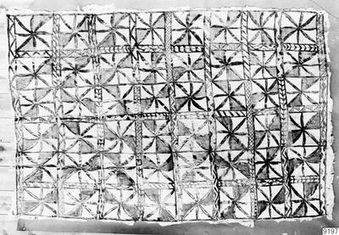Connect with Museum of World Culture
Contact this content partner to get more information about this item.
object analysis
- Description:
- T A P A Object: 1998.11.0441 Analysis by Annika Holmdahl Leadership in Sludge and Cultural Crafts, University of Gothenburg 2015-02-18 What road can this object have entered the collection of Gösta Sandberg? This object originates from Fiji, a volcanic island group in Melanesia in the Pacific consisting of more than 332 islands. According to my informant Tupou Moeofo working at TourismFiji This particular specimen comes from the island of Moce or the island of Taveuni and features wall ornamentation (Moeofo, 2015). I come forward in the text to which other uses tapa has. The information available in the catalogue card does not say when the item is available Cat, or where in Fiji it comes from. A name I got stuck for was the person who stood as purchaser, Viktoria Lindström. After searches of her name, I have come forward to the fact that it is likely to be a woman who ran a store in Stockholm, named Viktoria Lindström’s Antique Trade. My research has shown that there are many objects in Swedish and foreign museums collections acquired from or bought by just Viktoria Lind- stream antique trade. mainly during the 1950s. According to the catalogue card, it is Gunnel Sandberg who donated the tissue to the museum as being the person who distributed his collection after the estate. From this information I can only speculate that the object may be Purchased by Gösta Sandberg in Viktoria Lindström’s Antique Trade. How and by whom is tapa made? The technology to create tapa is found in several parts of the world, mainly on many other islands in the Pacific. Masi is the word for tapa used in Fiji, and it is also the name of the tree that is the raw material to this tapestry, in Swedish called hardwood. Tape-making is mainly carried out by women in different stages, sometimes in groups with varying numbers craftsman depending on the size of the weave. The trees are grown for this purpose and harvested when they is 8-12 months and is carried home to the women who then start the process. A cut is added with a knife along the stem and then the teeth are used to peel off the bark. Barken then rolled with the inside out, to simplify the next step when separating the surface and inner bark by means of a sharp knife. The inner bark is then divided together with equal wide and even strips that come together in a later step. These even strips rul- Glass once again in “wrong” hold and tied together with a string and put in soaked water overnight (Kooijman, 1977). The next step is the lending of tapa, which takes place with a bat with four sides (three rapes- Flute and a Smooth), called Ike, Towards a Long Tree Log, called Dudua. This equipment is often personal for each of the crafting women. When the long strip has been knocked out to about 6x the original width, it is soaked and then three pieces are joined (sometimes more, sometimes fewer) strips by putting them on top of each other and again being banked out to one even wider paragraph. The next step is to put two of these new pieces together, and through to fold and turn the piece together into an even bigger one. This element makes it a more rectangular shape and that the tissue is strengthened when there are so many layers (Kooijman, 1977). If the tissue produced is to be very large, several pieces made in the above way, by being “glued” with about 5 cm overlap by means of strengthening the cut from cooked Yabiaplanta, reminiscent of potato starch. What does the decoration imagine and how is it made? When the tapestry is banked and dried, the next step is the decoration. In Fiji, tapa is decorated with two-three different colours, reddish brown, red and black. The reddish-brown colour, cottage, is created by blan- da inner bark on the root
- Format:
- text
- Collections:
- Museum of World Culture
- Content partner:
- Museum of World Culture
- Availability:
- Not specified
-
Copyright status: Share, modifyFind out more about what you are able to do with this itemMore informationMuseum of World Culture has this to say about the rights status of this item:
http://creativecommons.org/publicdomain/zero/1.0/
What can I do with this item?Non-infringing useNZ copyright law does not prevent every use of a copyright work, and this item may be hosted by an international institute or organisation. You should consider what you can and cannot do with a copyright work.Share itThis item is suitable for copying and sharing with others, without further permission.Modify itThis item is suitable for modifying, remixing and building upon, without further permission.Check about commercial useYou'll need to confirm with the copyright holder using this item for commercial purposes.
Related items
Welcome and warm Pasifik greetings
The information on this site has been gathered from our content partners.
The names, terms, and labels that we present on the site may contain images or voices of deceased persons and may also reflect the bias, norms, and perspective of the period of time in which they were created. We accept that these may not be appropriate today.
If you have any concerns or questions about an item, please contact us.

